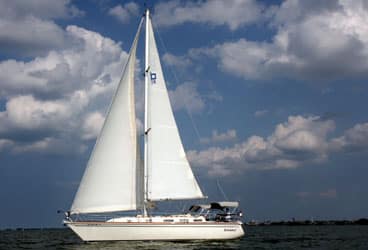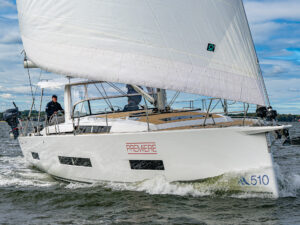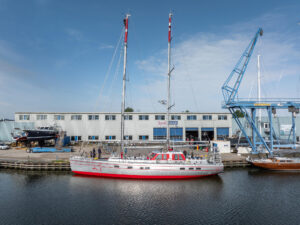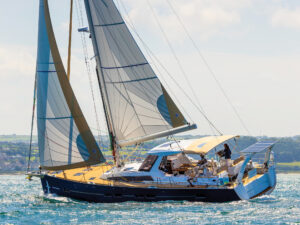
Pearson 38
In 1989, Bill Shaw, thinking to improve on the overmarketed “cruiser/racer” theme by emphasizing the “cruiser” aspect, developed the Pearson 38. Although Pearson Yachts closed its doors in 1990, the Pearson 38 had a short but successful run. In 1996, the Cal-Pearson Corporation reintroduced the Pearson 38 but launched only three boats before it, too, closed up shop.
The Pearson 38 has a flat sheer, a pronounced bow overhang, and a sugar-scoop stern with step-through transom. Low cockpit coamings and clean, appealing cabin-house lines offset the generous freeboard. Ample beam enhances both interior volume and form stability. Below the waterline, the boat has an externally mounted wing keel and an elliptical rudder. The solid, hand-laid-fiberglass hull and the balsa-cored deck are joined on an outward-facing flange. The joint is sealed with a polyurethane adhesive, bolted on 8-inch centers, and protected with a vinyl rubrail.
Belowdecks, the forward cabin features an island double berth, a hanging locker to starboard, and a locker to port. An opening hatch and two opening portlights allow for plenty of light and good ventilation. A solid teak bi-fold door opens from this cabin into the saloon, where a port-side settee and L-shaped seating around a centerline drop-leaf table to starboard easily seat eight for meals. The dinette also converts into a good-sized double berth. Aft of the port settee is an aft-facing navigation station and a wet locker.
The head compartment is located to port and aft of the companionway steps. It has a stainless-steel sink and a curtained-off shower area. A hinged seat covers the forward-facing head to keep it dry when the shower is in use.
Aft of the dinette and near the companionway, the L-shaped galley is fitted with an 8-cubic-foot icebox, a stainless-steel double sink, and a gimbaled two-burner propane stove with oven.
Aft of the galley is a second cabin with an athwarthships double berth that extends beneath the cockpit. A large hanging locker with built-in shelves provides stowage; an opening hatch and two portlights admit light and air.
The 38 is rigged as a masthead sloop with a keel-stepped spar, double spreaders, internal wire/rope halyards, and jiffy reefing. Standard equipment included a full-battened mainsail and a roller-furling headsail.
Under sail, the Pearson 38 tacks easily through 90 degrees and should make 6.5 knots in around 10 knots apparent. Its light-air performance is above average, and with judicious reefing, it can handle some pretty heavy air.
The Yanmar 3GM30F is beneath the galley sink. Accessibility, except for the oil dipstick, is near excellent. A panel in the cabin sole lifts out to reveal the stuffing box.
While well constructed, Pearson 38s aren’t bulletproof. Because they’re now two decades old, expect some deficiencies due to age and, possibly, to poor maintenance. Balsa-cored decks are always a potential source of problems, and portlights are prone to leaks.
The Pearson 38 is a solid, easily handled, and light-footed coastal cruiser that can accommodate two couples in comfort and safety. Its sailaway price 20 years ago was about $150,000. Expect to pay around half that for an average offering.
Gregg Nestor has written several books, including_ Twenty Affordable Sailboats_ to Take You Anywhere.
Specs:
Pearson 38
LOA 37′ 6″ (11.43 m.)
LWL 29′ 7″ (9.02 m.)
Beam 12′ 4″ (3.76 m.)
Draft 4′ 9″ (1.45 m.)
Sail Area (100%) 665 sq. ft. (61.8 sq. m.)
Ballast 6,050 lb. (2,744 kg.)
Displacement 15,175 lb. (6,882 kg.)
Ballast/D .40
D/L 262
SA/D 17.4
Water 100 gal. (379 l.)
Fuel 22 gal. (83 l.)
Engine 30-hp. Yanmar diesel
Designer Bill Shaw








